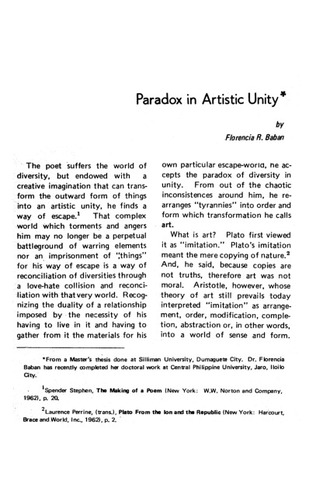Paradox in artistic unity
요약
The poet suffers the world of diversity, but endowed with a creative imagination that can transform the outward form of things into an artistic unity, he finds a way of escape. That complex world which torments and angers him may no longer be a perpetual battleground of warring elements nor an imprisonment of “things” for his way of escape is a way of reconciliation of diversities through a love-hate collision and reconciliation with that very world. Recognizing the duality of a relationship imposed by the necessity of his having to live in it and having to gather from it the materials for his own particular escape-world, he accepts the paradox of diversity in unity. From out of the chaotic inconsistences around him, he rearranges “tyrannies” into order and form which transformation he calls art.
What is art? Plato first viewed it as "imitation.” Plato’s imitation meant the mere copying of nature. And, he said, because copies are not truths, therefore art was not moral. Aristotle, however, whose theory of art still prevails today interpreted “imitation” as arrangement, order, modification, completion, abstraction or, in other words, into a world of sense and form.
기술
Journal article
추천 인용
Baban, F. R. (1976). Paradox in artistic unity.유형
ArticleISSN
0038-3600주제
Collections
- Southeast Asia Journal [188]


